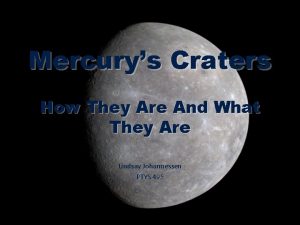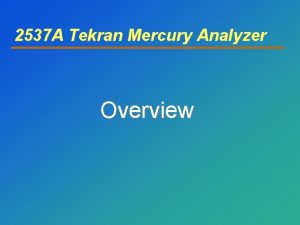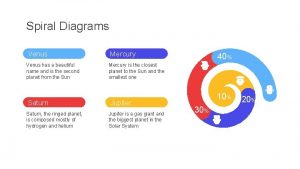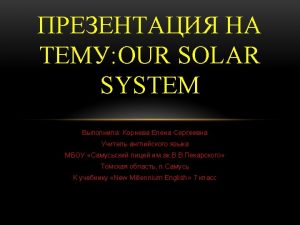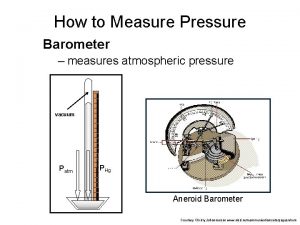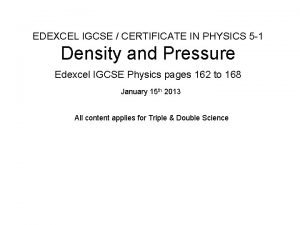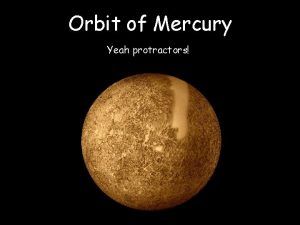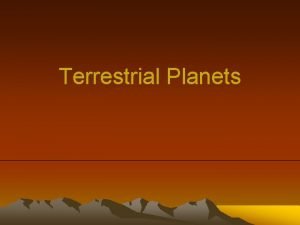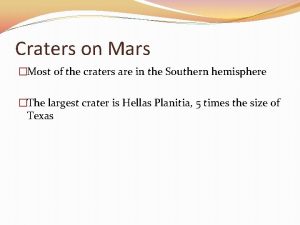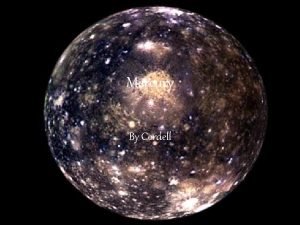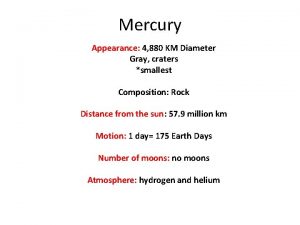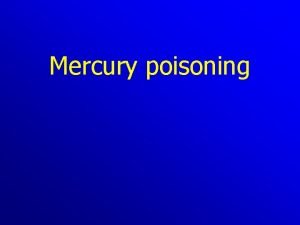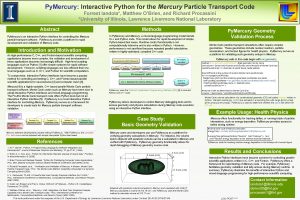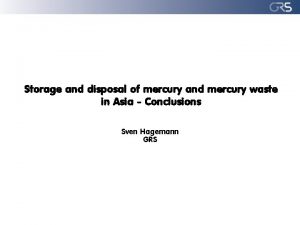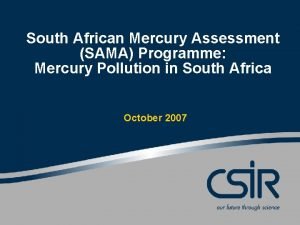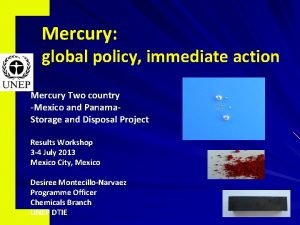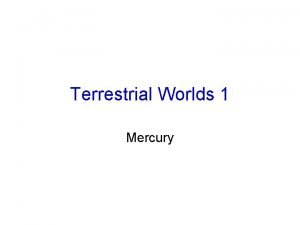Mercury Craters Mercury Craters Craters are shallower More

























- Slides: 25

Mercury – Craters

Mercury – Craters • Craters are shallower – More gravity • Craters are separated by smooth areas

Caloris Impact Basin • Giant crater • Very old – Subsequent lava flows inside it • Shock waves created “chaotic terrain” on other side of Mercury

Volcanism on Mercury • Extinct Volcanoes Discovered on Mercury • Many “plains” look like they were caused by volcanism Crater Flat crater floor Volcanic Vent Flat plains

Scarps on Mercury • Giant cliffs ~ few km tall • Hundreds of km wide

Scarps – Cracks in the Crust • Large metal core – Hot initially – Metal expands when hot • Core cooled – Metal shrinks – Portions of the surface “fell” – Cracks on the surface rock metal

Venus Images visible ultraviolet

How We Know What We Know • • • Magellan Many early spacecraft – limited success Venera – Soviet Landers – 60’s and 70’s Magellan – ’ 89 – Radar Mapping Venus Express (ESA) – 2006 to 2014 Akatsuki (Japan) – Since 2015 Akatsuki Venus Express Venera 9

Venus – Basic Facts • Size – Slightly smaller than Earth • Mass – Slightly less massive than Earth – Comparable density to Earth • Orbit: – 0. 723 AU, nearly circular – Venus year = 225 Earth Days • Rotation: – Backwards every 243 Earth Days – 2 Venus Days ~ 1 Venus Year Q. 35: Temperature of Venus • Atmosphere – Thick – 93 Earth pressure – Mostly Carbon Dioxide (CO 2)

Venera – Surface Images of Venus • Rocks similar to Earth rocks

Venus – Temperature and Climate • Surface temperature: 720 -750 K – hotter than hell – Hottest planet – strong greenhouse effect (CO 2) – Uniform temperature – thick atmosphere • No water – Surface – too hot for water or ice – Atmosphere – no water • Clouds – cover planet entirely in visible light – Clouds are sulfuric acid (H 2 SO 4) – “Rain” of acid, but evaporates before it hits the ground • Lightning – cause unknown – more than Earth

Venus in Radar • Clouds block views of surface • Magellan mapped 98% in radar • Continents and “seas” • Craters – rare, like Earth • Mountains • Volcanoes

Venus Surface Features and Composition • Continents are made of light rocks • No water in “seas” • Craters are uniformly distributed (? ) • Suggests entire planet was resurfaced < 1 billion years ago • No evidence of plate tectonics – all one plate – Probably thicker crust? • Composition similar to Earth

Mountains and Craters on Venus • Comparable in number and size to Earth • No small craters (thicker atmosphere) Q. 36: Volcanism on Venus

Volcanoes on Venus • Several objects that look like volcanoes

Volcanoes on Venus • At present, no actual volcanoes have been seen erupting, but. . . • Comparable in size to Earth • Sulfur compounds in the atmosphere indicate recent activity • Lots of evidence of recent eruptions – Lava makes pancake-like lava outflows • Generally agreed – Venus is still geologically active, like Earth

Venus vs. Earth • Why is Venus’s atmosphere so different from Earth? Early Venus: • H 2 O oceans, CO 2 atmosphere • Lots of water evaporates • Water is greenhouse gas • Water dissociated by UV • Hydrogen and Oxygen lost • CO 2 continues greenhouse Early Earth: • H 2 O oceans, CO 2 atmosphere • Little water evaporates • Some CO 2 dissolves in ocean • CO 2 combines with rocks • Plants convert CO 2 to O 2 • Runaway greenhouse effect

Mars Images Q. 37: Mars’s Appearance

How We Know What We Know • Many early missions (before 2000) • • • Mars Odyssey (’ 01 -present) Mars Express (’ 03 -present) Mars Exploration Rovers (’ 04 -’ 18) Mars Reconnaissance Orbiter (’ 06 -present) Mars Phoenix Lander (’ 08) • • • Mars Science Laboratory (’ 12 -present) MAVEN (’ 14 -present) Mars Orbiter Mission (’ 14 -present) Exo. Mars Trace Gas Orbiter (’ 16 -present) In. Sight (’ 18 -present) • More missions planned (’ 20 and beyond)

Current Spacecraft at Mars Orbiter Mission Mars Odyssey Exo. Mars TGO Mars Reconnaissance Orbiter Mars Express In. Sight Mars Science Laboratory MAVEN

Mars – Basic Facts • Size – Half the size of Earth – Twice the size of Mercury • Mass – 1/10 of Earth’s – Slightly less dense than Earth • Orbit: – 1. 38 AU, fairly eccentric – Mars year = 1. 9 Earth years • Rotation: – Once every 24 hours 40 minutes • Atmosphere – Thin – < 1% Earth pressure – Mostly Carbon Dioxide (CO 2) – Too thin for appreciable greenhouse effect

Mars – Pictures from the Surface

Mars – Pictures from the Surface • • Rocks and sand Reddish color due to iron oxide – aka rust

Mars – Climate Sun Mars Mild summer north Severe winter south Mild winter north Severe summer south Q. 37: Climate on Mars

Mars – Climate Sun Mars • • • Colder than Earth (far from Sun) – 130 K – 290 K Pressure fluctuates seasonally Southern hemisphere is more extreme
 Lirik lagu more more more we praise you
Lirik lagu more more more we praise you More more more i want more more more more we praise you
More more more i want more more more more we praise you Insidan region jh
Insidan region jh Venus craters
Venus craters Negative architecture perio
Negative architecture perio Mercurys craters
Mercurys craters Element name
Element name Knowing more remembering more
Knowing more remembering more The more you study the more you learn
The more you study the more you learn More love to thee o lord
More love to thee o lord Aspire not to
Aspire not to More choices more chances
More choices more chances Newton's law of inertia example
Newton's law of inertia example Human history becomes more and more a race
Human history becomes more and more a race The more you take the more you leave behind
The more you take the more you leave behind Tekran mercury analyzer
Tekran mercury analyzer Mercury (planet)
Mercury (planet) Diameter of the mercury
Diameter of the mercury Mercury vapour lamp
Mercury vapour lamp Atmospheric pressure
Atmospheric pressure P=f:a
P=f:a Dot mercury
Dot mercury Diameter of inner planets
Diameter of inner planets Mercury catalyzed hydration of alkynes
Mercury catalyzed hydration of alkynes Fc mercury
Fc mercury Mercury line
Mercury line





